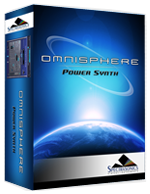EDIT PAGE –
Oscillator Frequency Modulation

FM stands for Frequency Modulation. FM has been a feature on synthesizers
since the 1960s, but it was most famously realized in Yamaha’s DX/TX series of
digital synthesizers in the 1980s. It was well known for producing glassy, metallic sounds and for creating
sound that are more harmonically complex.
FM is a form of audio synthesis where the timbre of one
waveform, called the “carrier”, is changed by modulating it with the frequency
of another waveform, called the “modulator” – hence Frequency Modulation
synthesis.
FM can take simple waveforms, like sine waves, and make them
sound quite complex. In Omnisphere,
the exciting thing is that any Soundsource or DSP waveform in Omnisphere can be
modulated with FM.
Each Layer in Omnisphere has a dedicated, hidden FM
oscillator, which acts as the modulator; so the other Layer’s Oscillator is not
required for FM synthesis to work. This dedicated Modulation Oscillator can utilize different waveforms and
both its frequency and depth can be shifted and modulated.
FM POWER SWITCH

Turns the FM modulating oscillator on or off.
FM KEYBOARD TRACKING

The small music-keyboard switch enables or disables Keyboard
Tracking. The Keyboard
Tracking button determines whether the modulator oscillator tracks the
keyboard.
If the Keyboard Tracking is turned on, then the modulator
oscillator will track the keyboard, meaning it will change pitch with the
keyboard. If Keyboard Tracking is
off, the modulation oscillator will not change pitch with the keyboard, it will
stay the same pitch no matter what key is played. This can be useful for more clangorous sounds.
FM FREQUENCY

Controls the frequency of the modulator oscillator. Because the modulator is unheard, it
does not change the pitch of the original Oscillator. Instead it alters the timbral characteristics of the
Oscillator’s waveform.
When this horizontal slider is set to just above the
minimum, it can produce LFO-type pitch effects. Moving the slider towards the maximum increases the
frequency and begins to oscillate fast enough that it will introduce timbre
changes.
The notches along the FREQUENCY slider are markers for the
frequency ratios that will produce the most musically useful results.
These musically useful values at the notches are decimal
versions of these ratios - 1/4, 1/2, 3/4 and 1 – represented as .250,
.500. .750 and 1.00.
Range 0.000 to 1.000
FM DEPTH

Controls the modulator’s depth. The higher the DEPTH slider is set, the more the dedicated
modulator is affecting the timbre of the OSCILLATOR.
Range 0.000 to 1.000
FM WAVEFORM

Many FM synthesizers use only Sine waves, but Omnisphere’s
modulator can use any one of four different waveforms. The four mode switches are for Sine,
Triangle, Sawtooth and Noise. Each
successive waveform has more overtones and so will add a brighter timbre.
In general FM works better when beginning with a simpler,
more pure sound than a sound with a lot of complexity to start with.


